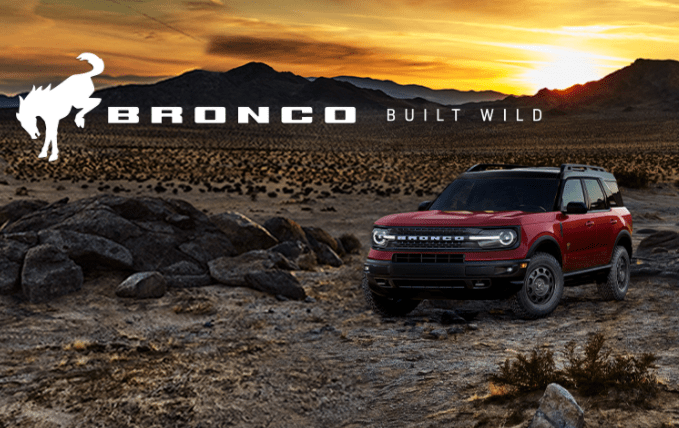Branding lessons from the relaunch of the Ford Bronco
The motor company is looking to find success by leaning into nostalgia, while also investing in new technology and trends.

Twenty-five years after it was discontinued, the Ford Bronco officially came out of retirement in a big primetime reveal this past July. While the announcement of the new Ford Bronco family of vehicles was not free of controversy or mixed reactions, Ford’s marketing has nevertheless been a master class in how to rebrand a company.
The three media outlets that Ford used to unveil its new line of Broncos—ABC, ESPN and National Geographic—are all owned by Disney. It’s interesting that Ford partnered with Disney for the unveiling because Disney’s own bit of self-rebranding in recent years is quite emblematic of what Ford has done. Disney’s recent modus operandi has been to take their own animated classics, like Beauty and the Beast and Mulan, and remake them into live action films that cater to more modern tastes and sensibilities. Since the original Disney classics were already re-imaginings of traditional folk and fairy tales, you could say that they’ve been remaking their remakes.
A powerful force that works in Disney’s favor with these live action remakes is nostalgia.
Nostalgia is what largely draws older audiences, who first saw the original animated versions in their youth, back into theaters for the remakes, bringing with them a whole new generation to enjoy these stories anew. Just like Disney, Ford has drawn from decades of their own history, heritage and nostalgia. With all things retro being cool right now, and the trend in nostalgia marketing, the timing was ripe for this sort of approach.
The elephant in the room
Of course, there are a couple of big differences between what Disney has been doing with classics like Beauty and the Beast, Mulan, and The Lion King. For one thing, no Disney movie past or present has ever had the cultural stigma attached to it that the Ford Bronco once did.
This is the obvious elephant in the room. Anyone who was old enough during the 1990s remembers that the Bronco is the vehicle that O.J. Simpson, with his friend Al Cowling at the wheel, rode in as they led the police on that infamous chase down a Southern California freeway in the summer of ‘94.
Ford’s solution to this navigating this stigma? Just steer around it. The company has mesmerized the public with words, sights, and sounds evoking the new Ford Bronco’s association with the lore of the great American outdoors and of rugged adventurism, in the process getting them to forget the crisis that gripped the nation decades ago. The vehicle’s own chronology makes this a pretty straightforward affair since the Simpson incident occurred in ‘94 and the ‘90s are not an era that evoke the Bronco’s nostalgic history anyway.
Simply snipping that era out from the proverbial film reel has therefore been a natural and logical move.
Ford’s master stroke has been to combine this retro nostalgia with the sex appeal of high tech features like the new Bronco’s Terrain Management System, its next-gen SYNC 4 infotainment system, and a multi-function color LCD instrument panel visually inspired by the first-generation Bronco, masterfully playing on the theme of retro cool-meets-modern swag, and tapping into the market of younger generations, many of whom don’t have any memories of the infamous freeway chase to begin with.
Staying nimble
In the same way that the rebranding of Disney is paralleled by the rebranding of the new Ford Bronco, the latter is also paralleled by Ford’s company-wide rebranding. Since the late 1990s, Ford’s market share has been on a steady decline. Eventually, Ford faced the same dilemma that many large companies with long histories have to face during changing times: whether to stick with the tried-and-true or to risk something new. With the former, death might come slower but it’s almost a sure thing, while the latter risks a faster demise, but also provides opportunities for growth. Blockbuster Video is an example of a company that stuck with what it knew and is now a fossil of a by-gone era. Ford, on the other hand, has been taking some bold risks and rebranding itself in the process ever since its change of leadership in 2019.
Chief among these bold risks was Ford’s big announcement of the Mustang Mach-E.
Make no mistake: attaching its best-known brand name, which is virtually synonymous with the muscular mythology of gasoline, onto a fully electric car was a significant risk on Ford’s part, one that wasn’t without a significant amount of backlash from fans. And then Ford announced the return of the Bronco.
What can other brands learn from this? It’s simple: Stay nimble.
We know that the general tendency for big companies is to rely on what’s worked for them and to be resistant to change. There’s actually a good reason for this. The public has come to expect a certain kind of experience from the McDonald’s, Starbucks, and Fords of the world, and anything that deviates from that is likely to ruffle some feathers—as we’ve seen with the mixed reactions to the Mustang Mach-E. However, Ford, like Disney before it, has shown that a company should never be too big to make changes. They’ve shown us how to rebrand a company’s image from aging dinosaur into future trendsetter through a combination of savvy marketing, bold leadership, and a willingness to take risks.
Judging from the number of customers who have already made reservations for the new Ford Bronco, and the growing waiting list of those eager to get their hands on one, Ford’s willingness to stay nimble and take risks has paid off.
Dr. Dustin York is an associate professor of communication at Maryville University.






